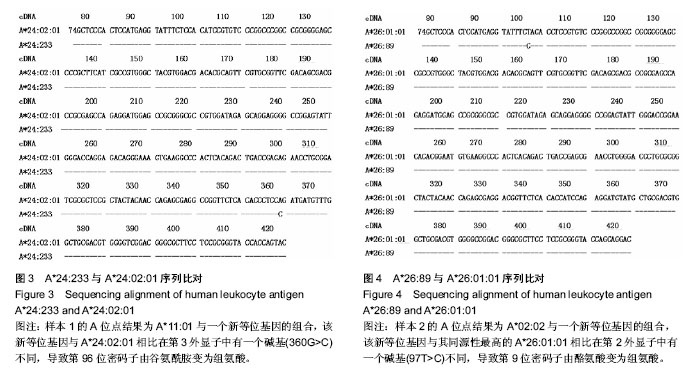| [1] 安仕萍,闫丽娜.测序技术在人类白细胞抗原基因分型领域的应用进展[J].医学综述, 2007,13(15):1189-1191.
[2] 陈男英,何俊俊,章伟,等. HLA-A新等位基因HLA-A*110106的核苷酸序列分析[J].中国输血杂志,2009,22(2):128-129.
[3] Robinson J, Waller MJ, Parham P,et al. IMGT/HLA Database--a sequence database for the human major histocompatibility complex.Nucleic Acids Res. 2001;29(1): 210-213.
[4] Robinson J, Mistry K, McWilliam H,et al.The IMGT/HLA database.Nucleic Acids Res. 2011;39(Database issue): D1171-1176.
[5] 章旭,李剑平,陈阳,等. HLA-B新等位基因B*4069的确认[J].中国输血杂志,2008,21(2):92-93.
[6] 章伟,朱发明,吕沁风,等.HLA-B新等位基因B*5136的确认和分析[J].中华医学遗传学杂志,2006,23(5):585-586.
[7] 陈男英,何俊俊,章伟,等. HLA-A新等位基因HLA-A*110106的核苷酸序列分析[J].中国输血杂志,2009,22(2):128-129.
[8] 张伯伟,郉培清,赵磊,等.10个HLA新等位基因的测序确认[J].中国输血杂志,2008,21(2):85-86.
[9] 王芳,黄霞,张涛,等. HLA-A新等位基因A*01∶01∶51的DNA序列分析[J].中国输血杂志,2013,26(6):530-532.
[10] 邢培清,张伯伟,程四国,等. HLA新等位基因A*110202的发现[J].郑州大学学报:医学版,2007,42(4):747-748.
[11] 程四国,张伯伟.HLA新等位基因A*9217家系调查分析[J].中国组织工程研究与临床康复,2009,13(53):10537-10540.
[12] 赵桐茂.HLA分型原理和应用[M].上海:上海科学技术出版社, 1989: 9-12.
[13] 黑爱莲,李伟,刘娜,等.中华骨髓库造血干细胞捐献志愿者HLA-A、B、C、DRB1、DQB1高分辨等位基因频率分析[J].中国输血杂志,2009,22(4):285-287.
[14] 刘晓华,冯智慧,胡彬,等.山东半岛地区汉族人群HLA-A、B、DRB1高分辨等位基因及单体型多态性的研究[J].中国输血杂志, 2010,23(8):592-595.
[15] 王小芳,刘孟黎,刘晟,等.陕西籍汉族造血干细胞献血者HLA-A、B、DRB1 高分辨多态性分析[J].中国输血杂志,2011,24(7):584- 589.
[16] 陈琳,焦立新,任海波,等. 吉林骨髓库汉族造血干细胞捐献者HLA-A、B、DRB1基因分布和单体型分析[J].中国输血杂志, 2010,23(1):35-39.
[17] 王兆福,张伯伟,马茹,等.河南省骨髓库汉族捐献者HLA-A、B、DR高分辨基因多态性调查分析[J].中国组织工程研究与临床康复,2011,15(31):5801-5804.
[18] 张志欣.HLA新等位基因的确认与研究及其在我国的开展[J].中国输血杂志,2008,21(2):81-83.
[19] Bjorkman PJ, Saper MA, Samraoui B,et al.Structure of the human class I histocompatibility antigen, HLA-A2.Nature. 1987;329(6139):506-512.
[20] Bjorkman PJ, Saper MA, Samraoui B,et al.The foreign antigen binding site and T cell recognition regions of class I histocompatibility antigens.Nature. 1987;329(6139):512-518.
[21] 鞠瑞青,陈琳,林乾飞,等.HLA 新等位基因HLA-B* 5145 的序列分析和确认[J].中国组织工程研究与临床康复,2010,14(44): 8249-8252.
[22] 孟庆丽,于卫健,梁晓华,等.DNA 序列分析鉴定HLA 新等位基因A* 2466[J].中国输血杂志,2008,21(2):89-91.
[23] 池永斌,范丽安.HLA 系统命名规则,2002[J].国外医学:输血及血液学分册,2003,26(3):194-209. |


